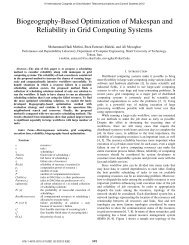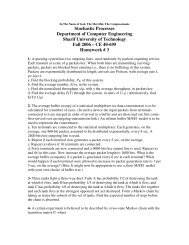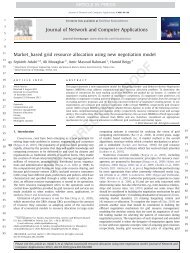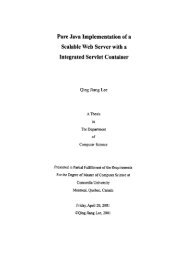A novel contention window control scheme for IEEE 802.11 WLANs.
A novel contention window control scheme for IEEE 802.11 WLANs.
A novel contention window control scheme for IEEE 802.11 WLANs.
Create successful ePaper yourself
Turn your PDF publications into a flip-book with our unique Google optimized e-Paper software.
Balador A, et al.: A Contention Window Control Scheme <strong>for</strong> <strong>IEEE</strong> <strong>802.11</strong> <strong>WLANs</strong>cw size upon successful packet transmission and collisionwith detecting a start of busy period <strong>for</strong> all activenodes based on network condition. Extensive simulationstudies <strong>for</strong> throughput, end-to-end delay, and packetdelivery ratio (PDR) demonstrate that the new mechanismreaches significant results compared with that <strong>for</strong>the <strong>IEEE</strong> <strong>802.11</strong> DCF. Moreover, extra simulations showthat the proposed <strong>scheme</strong> gives the best results such asthroughput, delay, and PDR in comparison with foursimilar <strong>scheme</strong>s: Multiplicative Increase and LinearDecrease (MILD), Double Increment Double Decrement(DIDD), Exponential Increase Exponential Decrease(EIED), and Linear/Multiplicative Increase and LinearDecrease (LMILD).The remainder of the paper is organized as follows.Section 2 describes the DCF function and categorizesas well as analyzes related work. Section 3 describesthe proposed <strong>scheme</strong> <strong>for</strong> <strong>control</strong>ling the value of cw.Section 4 presents and analyzes the simulation resultsin comparison with four similar <strong>scheme</strong>s: MILD, DIDD,EIED, and LMILD. Finally, Section 5 concludes the paperand discusses directions <strong>for</strong> further work.2. PreliminariesThis paper proposes a new algorithm/<strong>scheme</strong> andrelated background work is necessary.2.1 <strong>IEEE</strong> <strong>802.11</strong> DCF Access MethodThe <strong>IEEE</strong> <strong>802.11</strong> standard supports the DCF as a default,while the point coordination function ‡ (PCF) is usedoptionally [3]. <strong>IEEE</strong> <strong>802.11</strong> DCF is the most widelyused CSMA/CA access <strong>control</strong> mechanism. The <strong>IEEE</strong><strong>802.11</strong> uses the Request-to-Send (RTS)/Clear-to-Send(CTS) mechanism in order to reserve the mediumbe<strong>for</strong>e transmitting the packet. The <strong>IEEE</strong> <strong>802.11</strong> protocoluses the RTS/CTS-DATA-ACK sequence <strong>for</strong> datatransmission. In addition to physical carrier sensing, italso supports the virtual one. This is implemented inthe <strong>for</strong>m of a Network Allocation Vector (NAV), which‡PCF is used <strong>for</strong> managed (infrastructure) wireless networks and is locateddirectly above the DCF in the <strong>IEEE</strong> <strong>802.11</strong> MAC architecture.is maintained by every node. The NAV indicates theamount of time that must elapse until the current transmissionis complete and the medium can be checkedagain <strong>for</strong> idle status.The <strong>IEEE</strong> <strong>802.11</strong> DCF <strong>control</strong>s priority access to the wirelesschannel through the use of Inter Frame Space (IFS)time intervals between the transmissions of frames. The<strong>IEEE</strong> <strong>802.11</strong> DCF specifies four IFS intervals, which areused to provide different priorities:• Short IFS (SIFS) time intervals that have the highestpriority access to the channel and are used <strong>for</strong><strong>control</strong> packets• Distributed coordination function IFS (DIFS) timeintervals, which are used in the basic access methodin <strong>IEEE</strong> <strong>802.11</strong> DCF• Point coordination function IFS time intervalswhich are used in the <strong>IEEE</strong> <strong>802.11</strong> PCF mode• Extended IFS (EIFS) time intervals. EIFS is a longerIFS used by a station that has received a packet thatcould not understand. This is needed to prevent thestation from colliding with a figure packet belongingto the current dialog.Figure 3 shows the different inter frame space (IFS) timeintervals.According to <strong>IEEE</strong> <strong>802.11</strong> DCF, each node that has a datapacket <strong>for</strong> transmission sends a RTS packet and waits inorder to receive a CTS packet. Receiving a CTS packetmeans that the receiver is ready to receive a data packet.Transmitter must wait a SIFS time interval after receivingthe CTS packet and then begins to send its own datapackets. Be<strong>for</strong>e each node is allowed to transmit a RTSpacket to start communication, the nodes should listento the channel. If the channel is found as being idle <strong>for</strong> atime interval longer than DIFS, then the BEB algorithm isstarted. The BEB algorithm uni<strong>for</strong>mly selects the backofftime in the interval (0, CW). First of all, DCF sets cw withthe predefined value CW min. In other times, cw is doubledwith transmission failure up to another predefined valueCW max. When it reaches to CW max, it keeps its value withsubsequent failures.Figure 3: Inter Frame Space (IFS) time intervals [15].204 IETE TECHNICAL REVIEW | Vol 29 | ISSUE 3 | MAY-JUN 2012








